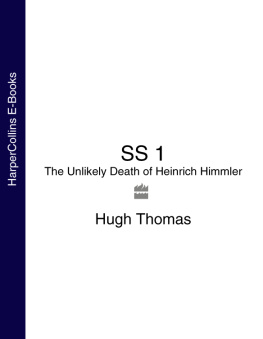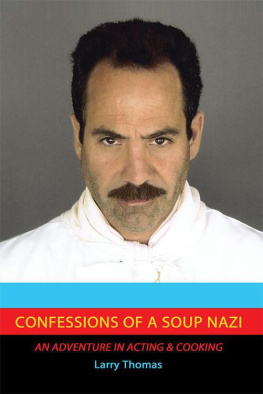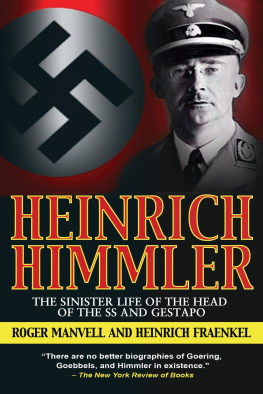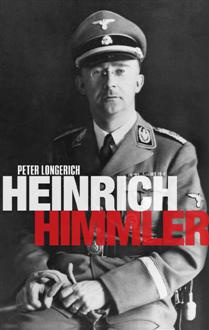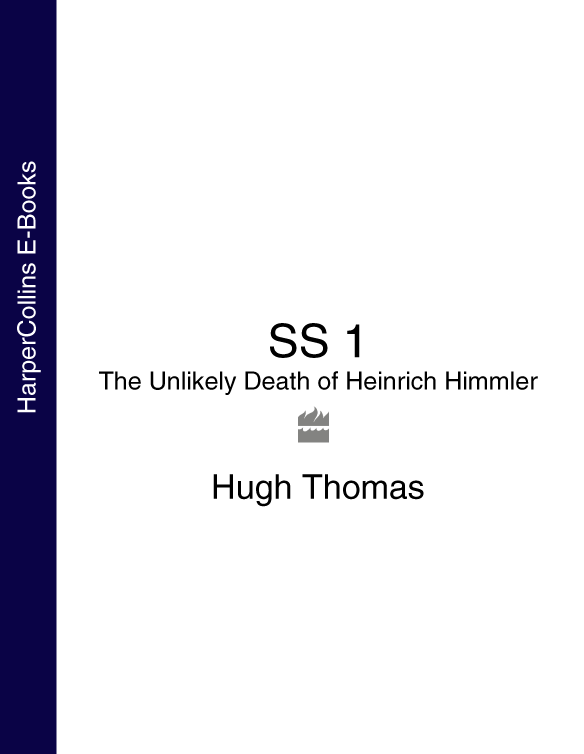
SS 1
THE UNLIKELY DEATH OF HEINRICH HIMMLER
Hugh Thomas

Contents
Reichsfhrer SS Heinrich Himmlers suicide by cyanide poisoning while in British custody on 23 May 1945 has never before been subject to scrutiny. As shocked Allied troops discovered the countless victims of Himmlers regime, none dissented from the unquestioning jubilation that met the demise of the architect of the Holocaust.
On 24 May 1945 the story of Himmlers death was broadcast to the world. Australian War Correspondent Chester Wilmot interviewed British Army Colour Sergeant-Major Edwin Austin, fresh from the scene of the suicide of Lneburg. Austin was a confident, down-to-earth interviewee who said exactly what a bluff NCO might have been expected to say. He was apparently guileless:
Before he arrived I didnt know it was Himmler; I was only told there was an important person whom I was to guard. As he came into the room not the arrogant figure which we all knew, but dressed in an Army shirt, a pair of underpants, with a blanket wrapped around him I immediately recognised him as Himmler. Speaking to him in German and pointing to an empty couch, I said, Thats your bed. Get undressed. He looked at me, then looked at an interpreter and said, He doesnt know who I am. I said, Yes I do; youre Himmler, but thats still your bed. Get undressed. He tried to stare me out, but I stared at him back, and eventually he dropped his eyes and sat down on the bed.
Austin relished his bit-part in history. His robust account was to become the official version of events. It has been repeated by historians ever since, in spite of the hundred-year ban imposed by the British on key documentation relating to the suicide, which one might have expected to inspire greater curiosity. Austins version of events has remained unchallenged until now.
In order to understand events surrounding the death of the prisoner identified as Himmler it has been essential to obtain first-hand information from men who were there at the time. Other witnesses far more credible than Austin were present at the suicide. I was fortunate enough to start my investigation at a time when key people, including doctors and dentists, were still alive and able to pass me their recorded data. I discovered that Himmler was not just discreetly interred: in fact the British ordered a post-mortem. Then months after the body was buried on Lneberg Heath, it was exhumed and a second post-mortem examination was conducted. Even after this second scrutiny, British inquiries into Himmlers death continued. None of this has been reported before.
It became evident that interest in Himmlers death was not just related to concerns about the suicides identity. Surprisingly, Kim Philby had set up a costly secret operation to lay to rest the ghost of a live Himmler. Other intelligence personnel and financiers revealed unsuspected intrigues and secret agreements, some seeming to suggest Himmlers post-war influence. Through investigation, the circumstances and the exact scientific facts about the death are now known. At long last we can savour the uncertainty that plagued Philby in 1946.
Critical documents relating to negotiations with Himmler in Stockholm at the end of the war have already vanished from the British Public Record Office. When the ban is eventually lifted, the file on Himmlers suicide is likely to be as empty as the grave on Lneburg Heath. This book is for those who do not want to wait until 2045.
This whole case is regarded by the Allied Counterintelligence officers, and in particular by the British, as being the most important single case in the history of counterespionage.
Unidentified officer, FBI files
In January 1946, in the fierce grip of winter, the defeated Reich had become a 143, 200-square-mile frozen madhouse. At the height of the Nazis power their empire stretched from the Atlantic coast of France to the outskirts of Moscow. Now Germany was half the size of France, with eight million refugees pouring in from the east to share the woes of 48 million citizens who were already confused, embittered and starving.
A proud empire lay dramatically humbled. Remnants of bridges were awash on her river banks. The stately Autobahns were pulverised by the treads of invading tanks. What little traffic there was picked its way laboriously along the smashed up roads, frequently stopping to let Allied convoys pass. Germanys great cities reeked of sewage. Workmen toiled in tattered clothes while women formed endless chains to pass them bricks, working all day and through the icy night. As they struggled to restore some kind of order their children collapsed at school from malnutrition and cold.
At the centre of this devastation was Nuremberg: the scene of Hitlers greatest triumphal rallies transformed into a grim stage for international retribution. The Albrecht Drer Haus stood in glorious isolation amid the ruins. The bombed-out red shell, miraculously propped up by its central beam, presented a surreal landscape. As distinguished writer Rebecca West observed, Nuremberg in 1946 looked more like a woodcut by Dali than by Drer. SS prisoners of war rebuilt the nearby Justizpalast at frantic speed. They continued to work throughout the marathon proceedings of the International Military Tribunal, which sat from November 1945 until mid-1948, looking for all the world like plaster-covered, maudlin clowns, wordless witnesses to their former leaders fates.
The Justizpalast had been adapted by the Nazis to achieve a level of efficiency that makes Henry Ford look prodigal. It housed twenty courtrooms; a penitentiary of meagre cells, each with a fifteen-inch window that denied any privacy; a prison yard, and a scaffold. In the glory days of the Third Reich, a man could be hauled in, charged, tried, convicted and hanged, all under one roof, before he had time to grow a six oclock shadow.
In 1946 the Justizpalast was the showcase for a unique collection of Nazi nabobs. If it were possible to ignore the macabre nature of the proceedings, Nuremberg offered a great spectacle for the discerning viewer. British prosecuting counsel Lord Elwyn-Jones likened it to a larger than life butterfly collection.under blazing lights on the squat rostrum in the middle of the court.
Anthony Marreco was to witness this ritual countless times. One of the British counsel for the prosecution, he was there to bring to justice members of allegedly criminal organisations, such as the Schutzstaffel (SS), the Sicherheitsdienst (SD), the Kriminalpolizei or Kripo, and the Geheime Staatspolizei (Secret State Police), unpopularly known as the Gestapo. Less openly, Marreco was also responsible for liaising between the Allied Secret Services and the judiciary. As the English and American intelligence agencies dominated proceedings to the exclusion of Russia and France, in effect he belonged to an exclusive Anglo-American club.
Marreco sensed the irony of seeing these men in the marble courtroom that had hosted the savage parodies of justice under National Socialism. How many helpless defendants had been condemned without pause by dour men in judicial robes tainted by swastika armbands? Now the Nuremberg trial judges sat before him, craning forward to avoid the freezing cold leather of their high-backed chairs. The emaciated figure of Chief Justice Robert H. Jackson, with his long, hairless head, hooded eyes and wrinkled neck, looked like a desiccated bald eagle perched in front of the stars and stripes of the American flag. In contrast stood German defending counsel Otto Kranzenbhler, an imposing man bolstered by self-importance and the ski suits under his robes.
Next page
